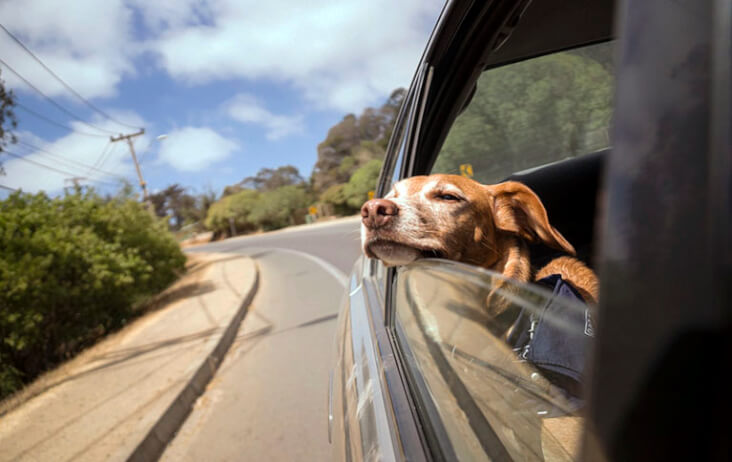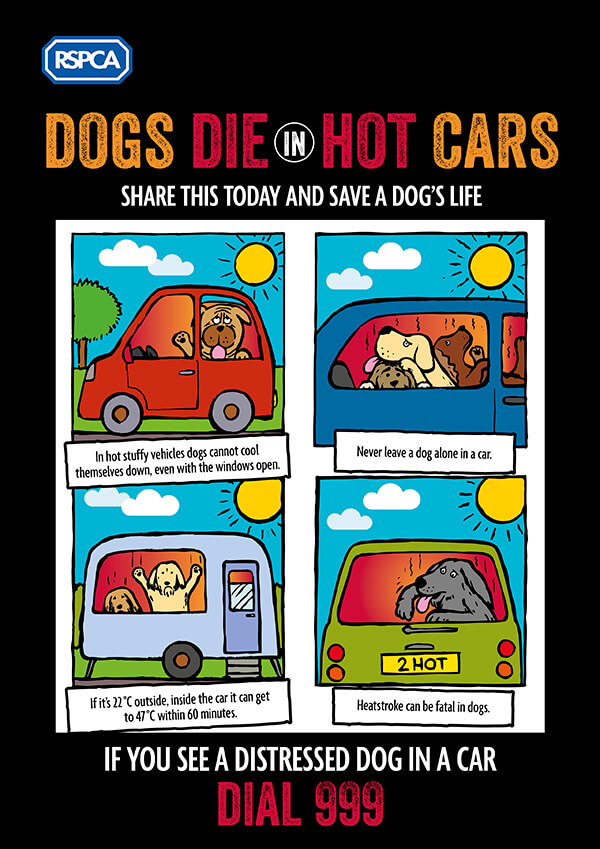They call these the “dog days” of summer.
And is it just us or does this year seem extra hot to you?
While all this summer sun can be an amazing time for you and your pet it can also be deadly.
When it is blazing hot outside many dogs are silently suffering.
In fact according to the DVM360 the peak months for veterinary practices are during high summer.
That’s why we’ve put this post together for you…
So you and your dog can get the most of the summer sun and avoid the risks.
When You Should Start Making Changes
Here’s Dr. Michael Lazaris’s golden rule…
Start making changes as soon as the temperature gauge hits 20ºC.
Temperatures above this increase your dog’s risk of heat stroke, which can be fatal if not treated.
Certain breeds, such as those with flat faces and giant breeds, are more susceptible to the heat.
Heat Stroke And How To Prevent It
What is heat stroke?
Heat stroke is when your dog’s body temperature starts to rise above normal (38.6C).
It is a common problem in dogs in the summer because they can’t sweat properly to lose heat. That’s because they can only sweat minimally through their paw pads.
Instead their main method of trying to cool themselves down is panting.
But panting becomes ineffective when the air they’re taking in is just as warm as the air they’re breathing out.
Now the most common causes of heat stroke in dogs are too much exercise on a hot day, or being left inside a hot car.
Here’s what you should look out for if you feel the heat is getting to your dog…
The Symptoms Of Heatstroke
- Temperature above normal (38.6C). In some dogs with heat stroke their temperature can reach 40-43C.
- Excessive panting
- Drowsiness
- Uncoordinated movements
- Drooling
- Either dark red or pale gums
- Vomiting and diarrhoea
- Collapse
What To Do If You Are Concerned About Heatstroke
The first thing you want to do is to call up your personal veterinarian and tell them what is going on.
The treatment for heat stroke mainly involves cooling your dog down and replacing the fluids that they have lost.
A vet might use cold showers or baths, wet towels and fans. They might also put your dog on a fluid drip.
If your dog’s heat stroke is severe, he might have to stay at the vet for several days.
But if it is caught in time, most dogs will make a full recovery.
This is why it’s key to be alert to your dog’s behaviour in hot weather, but more important to be proactive in avoiding it.
How To Help Your Dog Avoid Heatstroke
- Never leave your dog in a hot car, caravan, shed or conservatory.
- Always make sure they have access to shade.
- Provide cold, clean drinking water at all times.
- Don’t over exercise on hot days.
- Walk your dog early in the morning or late at night to avoid the hottest weather.
- Don’t let your dog become overweight.
- Have your dog clipped or stripped regularly in the summer months to help keep them cool.
- Use pet friendly sun cream for exposed parts of your dog’s skin, such as their nose and ears.
- Cool your dog down with cool water if they start to become too warm.
Here’s Which Dogs Are More At Risk Of Heatstroke:
- Pugs, bulldog breeds and boxers. Their breathing is already impaired by their flat faces or short noses so they find it harder to pant.
- Breeds with long or thick coats, such as Chow Chows and Golden Retrievers.
- Large dogs, particularly giant breeds like Newfoundland or Bernese Mountain Dogs.
- Elderly dogs.
- Overweight dogs.
- Dogs with a heart or lung condition that affects their breathing.
- Dogs who have suffered from heatstroke in the past.
Whatever the breed, size and age of your dog it is important to keep a careful eye on them during hot weather. And act quickly if you spot signs of heat stroke!
Avoiding Burned Paws: The Seven Second Pavement Test
Have you ever tried to walk barefoot around the swimming pool on your summer holiday?
Do you recall the pain inflicted on your feet?
If the answer is yes, you can imagine how a dog’s paws feel after walking along a hot pavement in the summer sun.
Pavements can reach scorching temperatures on sunny days. It is important to check whether it is safe for your dog before heading out.
This easy trick will help you decide…
Simply place your hand onto the pavement. If you can’t hold it down for seven seconds, it’s too hot to walk your dog!
You can help get around this on super hot days by walking on the grass instead.. Or you can invest in some special booties to protect their paws.

What to do with your dog on hot days
On summer days it is best to walk your dog first thing in the morning or in the late evening to avoid the hottest hours of the day.
It also might be a good idea to reduce walking time so that your dog isn’t overexerted.
If you decide to take a shorter walk, consider playing some less strenuous games when you get home. You could hide treats around the house or garden for your dog to sniff out. Or use a Kong or treat puzzle ball to keep them amused.
Some dogs also love to swim and swimming can provide great exercise and relief on hot days.
If your dog isn’t so keen on the open water, try filling a paddling pool in the garden for him to play in. Or use a sprinkler and watch him chase the jets of water for hours of entertainment.

Tips About Dogs In Hot Cars
Hot, sunny days can be especially difficult if you need to travel with your dog in the car. Cars can become very hot, very quickly. This can make it tricky to keep your dog cool.
You probably already know to never leave your dog unattended in a car. Heat stroke can happen in minutes. This applies even if your car is parked in the shade and has the windows open.
If you see a dog in a hot car and the dog is in distress, call 999. This is an emergency situation.
If the dog is not yet in distress, make a note of the car model, colour and registration plate. Call the RSPCA. Or if you are at a supermarket or event, try and get the situation announced over the tannoy.
Don’t break a car window to rescue the dog. You could be taken to court for criminal damage. Call 999 first and take the advice of the police. They will most likely be able to come to the scene and provide assistance.
Once a dog has been removed from a hot car, you should follow the cooling procedures given above. Contact a vet for advice.

Dogs die in hot cars – An infographic created by the
If you need to take your dog on a car journey in hot weather, here are a few tips to keep them cool:
- Keep the car cool and well ventilated by travelling with windows open or air conditioning on.
- Use sun shades over the windows to keep out direct sunlight.
- Try to travel early or late in the day to avoid midday heat.
- Use a handheld fan or mist spray to keep your dog cool.
Some Of Summer’s Pests
Whilst summer is always fun for you and your furry friend, it also comes with a few added pests. These can be an annoyance or danger to your dog.

Stings (Bees, Wasps and Hornets)
A bee, wasp or hornet sting can be painful for your dog and cause swelling. They are usually mild enough to treat at home.
But if a dog receives multiple stings at once, they may go into shock.
Stings could also cause anaphylactic shock if your dog has an allergic reaction. This is more common if your dog has been stung in the past.
If the insect leaves its sting in your dog, carefully scrape it out with a credit card or similar. Don’t squeeze it, or use tweezers. This could release more venom into your dog.
Apply a cool pack or an ice pack wrapped in a towel to the affected area. This will reduce swelling.
Your vet might be able to prescribe your dog an antihistamine. Do not give dogs medicine intended for human consumption – these could be poisonous.

Ticks
What are they?
Ticks are small parasites that survive by sucking the blood of mammals. They can climb onto your dog when he brushes past what they are sitting on.
Some ticks carry Lyme Disease, which is a serious bacterial infection.
Where and when are they found?
Ticks are found in grassland and woodland. They can be found all year round, but are more common in Spring and Autumn.
How do I remove a tick from my pet?
If you find a tick on your dog, it is important to remove it as soon as possible.
Use a tick removal tool. These can be found in pet shops or veterinary surgeries.
Twist the tick off, don’t pull or squeeze. You don’t want to leave its head buried in your dog or squeeze blood back into his body.
Lyme Disease
Lyme Disease is carried by some ticks. It is a bacterial infection that can be serious if not treated.
The symptoms are:
- Depression
- Loss of appetite
- Fever
- Lameness
- Swollen and painful joints
- Swollen lymph nodes
- Lethargy
If you catch it quickly, Lyme Disease can be treated with antibiotics. If you think your pet has it, contact your vet.

Adders
What are they?
Adders are the UKs only venomous snake. Their bites rarely kill but they can be painful.
What do they look like?
Adders are roughly 50-60cm long. They can vary in colour from light brown to dark brown or black with red eyes. They have a black or brown zigzag pattern along their back and a V or X shaped marking on the back of their head.
Where are they found?
Adders are usually seen in woodland, moorland, sand dunes and rocky hillsides. Most commonly they are found in South and South West England, western Wales and in Scotland.
They are most active between April and July in the afternoon. You can often find them basking in the sun.
Is my dog likely to get bitten?
No. Adder bites are rare because they only bite in self defence. This might be if they’re stepped on or disturbed by your dog.
Puppies and curious dogs are most likely to accidentally provoke an adder.
What does an adder bite look like?
If your dog is bitten by an adder there will be swelling around the wound. You might be able to see two puncture wounds. Dogs might also be bleeding, bruised or appear nervous.
What is the treatment?
Seek a vet’s attention immediately. Try to carry your dog instead of letting him walk. This will stop the venom spreading further.
If venom is absorbed by your dog, his reaction might be more severe. However, 96-97% of dogs survive adder bites.
Treatment involves administering fluids, rest and sometimes anti-venom.

Summary: A Helpful Checklist
We hope this post has helped you out with a few ways you can help you dog stay cool this summer.
For a quick summary of some of the most important points you we have put together a ten top tips check list for you below.
Feel free to save it or print it out to keep it top of mind on those days the gauge goes over 20ºC.

References
https://www.dvm360.com/view/when-veterinary-clients-spend-most-and-least
https://www.vets-now.com/summer/when-is-it-too-hot-to-walk-a-dog/
https://www.countryliving.com/uk/wildlife/dog-breeds/a32913168/dog-breeds-higher-risk-heatstroke/
https://www.pdsa.org.uk
https://www.rspca.org.uk/
https://www.thekennelclub.org.uk
https://www.vets4pets.com/
https://www.bluecross.org.uk/
Eldridge, Carson, Carson and Griffin, ‘Dog Owner’s Home Veterinary Handbook’, 4th Edition, (2007).







Comments